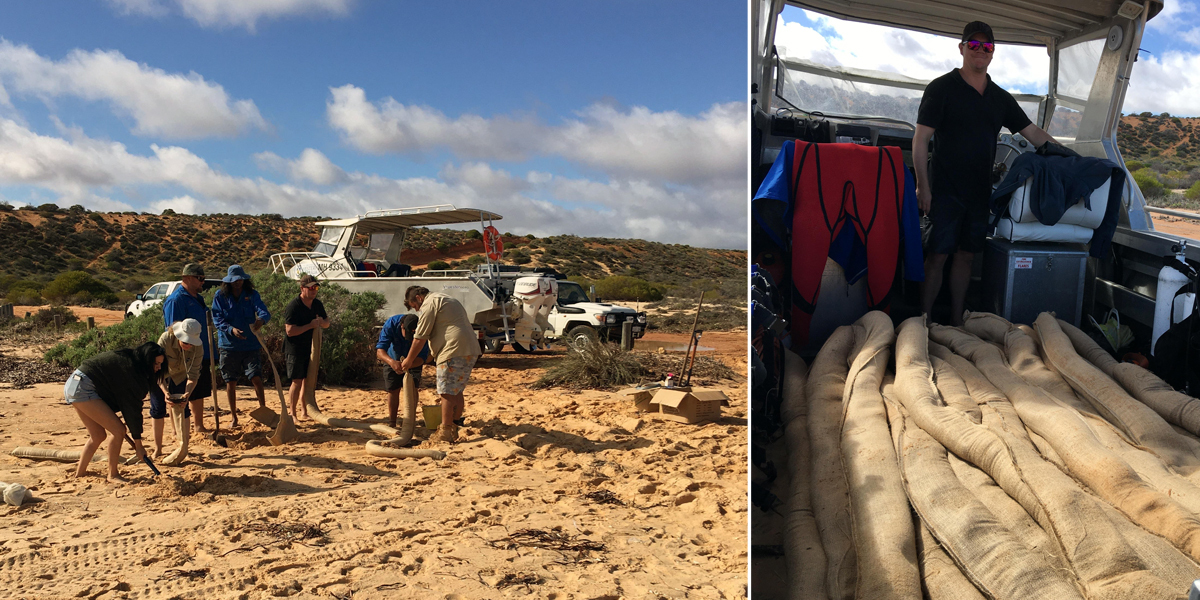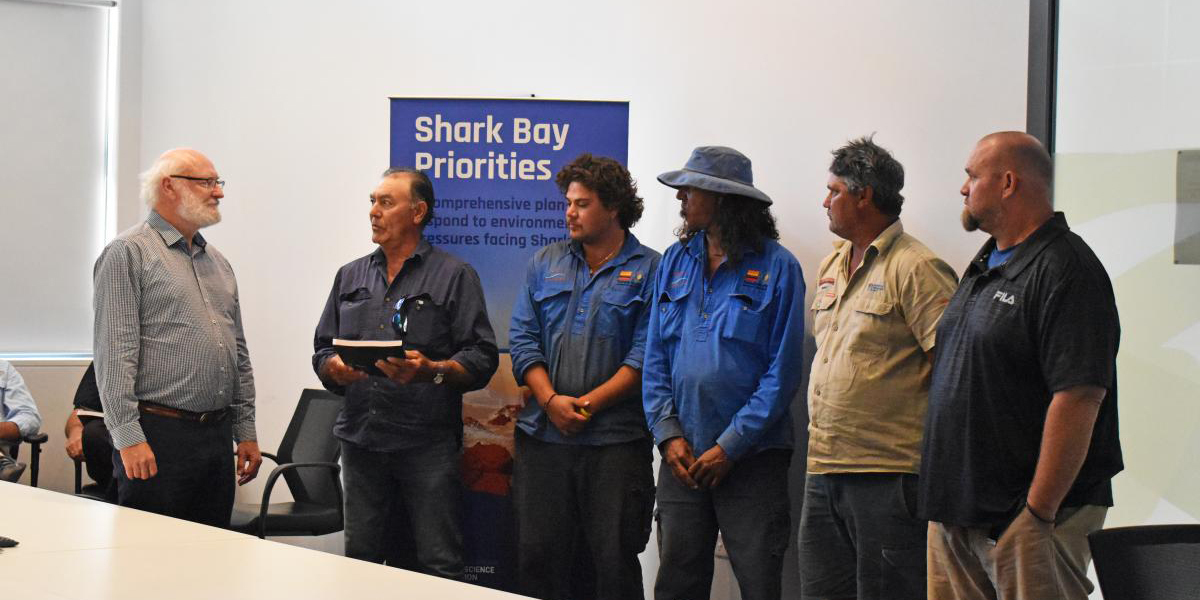November 6, 2020

University of Western Australia (UWA) researchers and Malgana Rangers conducted a joint workshop in August as part of a Marine Biodiversity Hub project to assist the natural recovery of seagrasses at Shark Bay.
In this final of four workshops, the researchers and rangers worked on developing and trialling seagrass recovery techniques. The rangers also completed their conservation and land management training, which includes seagrass habitat restoration.
The Shark Bay World Heritage Site is known as Gathaagudu (two waters) to Malgana Traditional Owners. This region experienced an unprecedented heat wave in the summer of 2010–2011. Sea-surface temperatures spiked 2–5°C above long-term averages, devastating more than 1300 km2 of dense seagrass meadows.
Widespread loss of food and habitat caused declines in many species. Some of the species affected are culturally significant, including green sea turtles (Buyungurra), dugong (Wuthuga), cormorants (Wanamalu) and bottlenose dolphins (Irrabuga). The two large temperate seagrasses Amphibolis antarctica (wire weed) and Posidonia australis (ribbon weed) tend to recover slowly and this prompted efforts for assistance.

'Snagging' wire weed
The selection of suitable plants and seedlings for restoration is guided by knowledge of their genomic diversity and adaptive traits, and different restoration methods have been applied to the plants at different growth stages (seeds, seedlings, and adults).
In August, the focus was on wire weed, as July to September is the peak dispersal time for the budding seedlings. The wire weed seedlings look like smaller versions of adult plants, but spend several weeks to months floating with the currents and tides, before eventually sinking to the seafloor and catching hold of something to grow on.
A wire weed seedling-retention technique involving ‘seagrass snaggers’ was trialled. These long hessian socks were developed by researchers after they trialled hessian bags in 2019. Seagrass snaggers can be filled with local beach sand. The hessian (and wire) will naturally break down over time. Ninety snaggers have been deployed at two locations, close to existing wire weed meadows.
This method is simple, cheap, and easy, but timing is critical. The snaggers must be in place before the major release of seedlings begins. Ongoing work by Malgana Rangers on Sea Country means snaggers in coming seasons can be appropriately timed. The snaggers should last about 18 months: long enough for new seedlings to establish.



Seeking signs of success
Measuring the success of restoration activities takes time (years rather than months) and requires multiple visits, particularly for the larger temperate species.
In October 2020, UWA researchers measured the return of ecosystem function at several restoration sites. These sites were established through traditional transplanting of adult plants. Some sites were planted in 2015 and 2018 (before the Hub project) and two new sites were established with Malgana Rangers in March 2020. The return of ecosystem function was determined by survival and shoot counts of transplants, and the presence of biodiversity (fish and invertebrates).
There was expanded cover and increased shoot density at the older restoration sites. Fish diversity was highest in the oldest wire weed sites, and the survival of transplants was very high in the two Malgana Ranger sites, with lots of new wire weed shoots.




During the October visit to Denham, Professor Gary Kendrick of UWA formally presented the report A Snapshot of Marine Research in Shark Bay (Gathaagudu): Literature Review and Metadata Collation (1949-2020) to Malgana Elder Bobby Hoult, and Benny Bellottie. This comprehensive report summarises the past 70 years of marine research at Shark Bay.

The Wirriya Jalyanu (seagrass) Festival was postponed due to unforeseen events that meant many members of the Malgana community would not have been able to attend. The Festival will now be held on 7/8 April 2021.
Related information
- Working together to restore seagrasses at Shark Bay (story)
- Seagrass (wirriya jalyanu): giving life to sea country of Shark Bay (Gathaagudu) (fact sheet 2021)
- Restoration Showcase June 2020, "Assisting restoration of ecosystem engineers through seed-based and shoot-based programs in the Shark Bay World Heritage Site" (webinar presentation)
- Kendrick GA, Nowicki RJ, Olsen YS, Strydom S, Fraser MW, Sinclair EA, Statton J, Hovey RK, Thomson JA, Burkholder DA, McMahon K, Kilminster K, Hetzel Y, Fourqurean JW, Heithaus MR, Orth RJ (2019). A systematic review of how multiple stressors from an extreme event drove ecosystem-wide loss of resilience in an iconic seagrass community. Frontiers in Marine Science 6: 455.
- Sinclair EA, Edgeloe JM, Anthony JM, Statton J, Breed MF, Kendrick GA (2020). Variation in reproductive effort, genetic diversity and mating systems across Posidonia australis seagrass meadows in Western Australia. AoB PLANTS 12: plaa038.
- Strydom S, Murray K, Wilson S, Huntley B, Rule M, Bessy C, Kendrick GA, Burkholder D, Fraser MW, Zdunic K (2020). Too hot to handle: Unprecedented seagrass death driven by marine heatwave in a World Heritage Area. Global Change Biology 26: 3525-3538.
- Tan YM, Dalby O, Kendrick GA, Statton J, Sinclair EA, Fraser MW, Macreadie PI, Gillies C, Coleman R, Waycott M, van Dijk K-J, Vergés A, Ross JD, Campbell ML, Matheson FE, Jackson EL, Irving AD, Govers LL, Connolly RM, McLeod IM, Rasheed MA, Kirkman H, Flindt MR, Lange T, Miller AD, Sherman CDH (2020). Seagrass restoration is possible: Insights and lessons from Australia and New Zealand. Frontiers in Marine Science 7: 617.
- Log in to post comments
